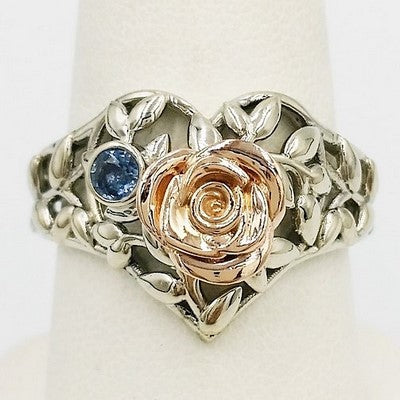What is white gold made of ?
While natural and yellow gold has been known to man for more than 6000 years (as far as we know), white gold only appeared at the beginning of the 19th century, and few people know what it is made of.
Most of the gold ring sold in the US are white gold rings, and this is a worldwide trend visible in Mexico, France and Latin America.

That graph shows you the comparison of US online demand between yellow gold rings (in red) and white gold rings (in blue) since 2004. We can see that the demand for white gold rings is much higher than the demand for yellow gold rings.

Although the demand is present, few know what white gold is and how it is used in jewelry. That article will undoubtedly help you in your search for information about white gold.
INDEX
- What is white gold?
- White gold history
- White gold allergy
- What is rhodium used for?
- Why white gold turn yellow?
- How to identify white gold at home?
- White gold price
 |
 |
 |
1. White gold composition
White gold is an alloy composed of fine gold, pure yellow gold that you know well, with other metals that will give it a white / gray color.
The only information available on the white gold of your ring will be the gold title, given by the mark on the jewel, of 9K, 10K, 14K, 18k or even 24k (in the case of pure gold jewelry), which indicates to you the proportion of pure gold of the jewel.
Composition of 750 white gold:
A ring in 18-karat white gold (or 750/1000) is made of 75% pure gold.
But what about other metals allied to gold? Well, we do not know !!
The white gold alloys are made according to certain recipes that can vary, from mixtures of commercial metals and some are more or less secret, according to the jeweler or the company considered.
Here are some examples of known white gold alloys:
- 20k: Composition of 20 carat white gold (833/1000): 83.3% of fine gold + 16.7% of Palladium
- 18K: Composition of white gold 18 carats (750/1000): 75% of fine gold + 18.5% of silver + 1% of copper + 5.5% of zinc
- 14K: Composition of 14 k white gold (583/1000): 58.3% of fine gold + 17% of silver + 17% of copper + 7.7% of zinc
- 9K: Composition of 9 carat white gold (375/1000): 37.5% fine gold + 62.5% silver
For obvious reasons, pure white gold does not exist, pure gold is only yellow. Check our post about the karats of gold here.
The French and international law is very strict as to the respect of the gold content announced by the mark of the jewel, but nothing is done to inform on the composition of the alloy of gold.
Some gold alloys tend to give a light gray or gray tint to yellow to gold, while others give it a more pronounced gray-white color.

In this image, we can see yellow gold on the left, in the center, the alloy of various metals used to make white gold from yellow gold, and to the right of 14-karat white gold. We notice the gray color pulling on the yellow of this alloy.
2. White gold history
White gold is a young metal that has only been known for a little over 200 years. Historians estimate its appearance at the beginning of the 19th century.
In fact, one of the first mentions of white gold in literature was in the book "L'art du Bijoutier" (The Art of the Jeweler) published in 1823 in France, whose author Louis-Nicolas Vauquelin describes how he obtained white gold by mixing platinum with pure gold.
The first patent on white gold in Europe was granted in 1912 to the German chemist Carl Louis Ullman. In his patent, Ullman describes how to obtain white gold with a mixture of pure gold, platinum and palladium.
But it is assumed that the knowledge of German jewelers predated that first patent.
You can learn more about the history of white gold by reading that article.
3. White gold allergy
We have seen that we can make white gold with certain metals alloyed with yellow gold. There are many ways to obtain white gold from yellow gold, but jewelers look for a white gold alloy that is also as economical as possible and does not cause inconvenience to users in the form of allergies.
Palladium and nickel are metals that are very effective in giving yellow gold its white color. Below, you can see a palladium ore on the left and nickel on the right.
 |
 |
But these metals have drawbacks:
- Palladium is as expensive or even more expensive than gold according to world market prices
- Nickel very often causes allergic reactions on the skin, to the point that its use was prohibited or limited in France (and Europe) by the decree of July 18, 2000. It is estimated that 13.5% of the population is naturally allergic to nickel. So most people allergic to white gold are in fact allergics to the nickel plated onto their white gold ring.
So, for cost and health reasons, white gold is usually made from metals that are non-allergenic and cheaper. So much so that many white gold alloys eventually tend towards a yellowish color. Here you can see the difference between two types of white gold with different bonds and what they look like when the white gold is raw when it comes out of the casting stage.
 |
 |
On the left we see an 18-karat white gold ring fresh from the foundry. We notice the white color of the gold in its raw state, unpolished and without rhodium, a sign of the quality of the white gold alloy used. On the right, we see another type of alloy that tends more towards yellow.
4. The use of Rhodium for white gold making
Since white gold may not be all that white, it is rhodium plated to give it a truly white appearance. The color of the white gold depends of the other metal components added to the pure yellow gold to make the white gold.
Why?
Well, white gold is never as white and shiny as rhodium, we have become accustomed in jewelry to depositing a plating on the metal of the ring giving a better visual effect.
In fact, rhodium is so brilliant that in a diamond ring it is difficult to distinguish the brilliance of the diamond from the brilliance of the rhodium from afar.
Please note that platinum is also sometimes used instead of rhodium. These two metals are part of the same group of metals and have similar properties. The point is that that white rhodium plate improves the visual appearance of the white gold ring.
Generally, a white gold ring without rhodium plating is called gray gold.
 |
 |
5. Why does white gold turn yellow sometimes ?
Therefore, you will have understood that the yellowing of your white gold ring is not due to dirt or aging gold, but rather due to the rhodium (or platinum) plating of your ring vaning away.
Bumps, friction, and wear and tear on your ring tear away microscopic pieces of your ring's rhodium plating, revealing its natural gold color.
The solution to the yellowing of your ring will therefore consist of taking it to your jeweler who, after cleaning and polishing the jewel, will once again deposit a layer of rhodium on it to restore its new appearance.
Below, you can see the example of a white gold scorpion ring without its rhodium plating next to the same ring with white rhodium plating.
 |
 |
6. How to identify white gold?
Strictly speaking, it is not possible to recognize white gold with your eyes only.
In fact, as the outer color of the jewel is due to a surface coating, it is impossible to visually recognize white gold. Silver with rhodium will have the same color as white gold with rhodium.
To test a white gold piece of jewelry, you must file the surface and test it with acid. In this way, the jeweler will be able to confirm that it is white gold and what the fineness of the metal of your jewelry is.
After verification, you can put a rhodium plate back on the jewelry.
White gold versus Sterling silver
White gold differs from silver in its density. Gold being denser than silver, a person accustomed to it can tell if the jewel is gold or silver.
- The density of silver is 10.5 when the density of 18K white gold is 15, 50% denser than silver
- White gold is harder than silver, so it is easy for the jeweler to recognize white gold when working it
- Without rhodium plating, polished silver is whiter and brighter than white gold
White gold versus Platinum
White gold is also distinguished from platinum by its color and density, with platinum being the densest of all precious jewelry metals.
- The density of platinum is 21.5 when that of 18k white gold is 15, so 950/1000 platinum rings are 30% denser and heavier than white gold rings
- Polished, platinum has a more pronounced gray color than white gold which looks whiter and slightly yellowish
7. White gold price
Common white gold has the same price as yellow gold, due to using common alloys. But it will need to be rhodium plated every 18/24 months to regain its color.
As for white gold with palladium, which looks whiter and can be used polished without rhodium plating, this type of gold is more expensive to purchase but does not require as much maintenance of the ring in the form of rhodium plating to maintain its white appearance.
Here, some examples of white gold jewelry made in the Vivalatina jewelry workshop.
 |
 |
 |
 |
More information :


Comments
Garry Perkins said:
Outside of France, there are many different alloys of white gold. For example, many still use nickel, along with palladium and zinc to whiten the metal, but often chromium and molybdenum are also added for strength and ability to polish. When Rhodium is not obscenely expensive, it makes a great addition to white gold that can show up in polishing. When working with white gold, one can tell the presence of palladium and rhodium from how much trouble finishing the gold causes.
In general, zinc-white gold will yellow, but nickel/palladium white gold, especially bright white alloys (especially 14k) will actually maintain a white standard for decades, and the gold will re-polish without issue. Rhodium plating is not necessary. In addition, 10k gold can and should have a bit more whitening elements other than simply adding more silver.
In general, nickel gives a whiter gold, especially with palladium and a small amount of chromium.